As Spanish conquerors and colonists intermarried with Filipinos, those Spaniards with coats of arms would have been entitled to pass them on to their descendants in the Philippines. Several of these shields are collected in the volumes of the Heraldario español, europeo y americano by Vicente de Cadenas y Vicent, Cronista Rey de Armas.
(Although many Filipinos share the same family names of Spanish settlers, only those with documented blood or adoptive ties inherit the right to use their coats of arms. In fact, most Filipinos have absolutely no blood or adoptive relationship to any Spanish family of the same name: Spanish names were simply assigned during colonization. Filipinos today are encouraged to design their own coats of arms that can be shared with generations to come.)
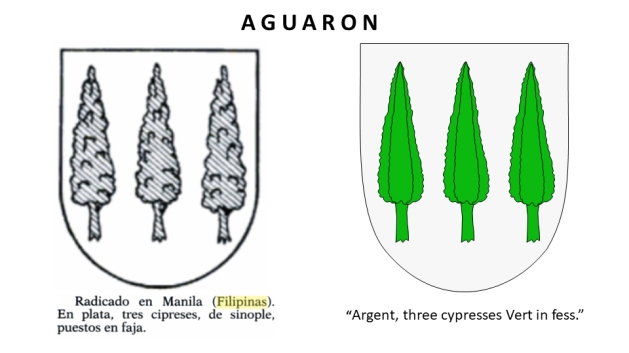
Aguaron – Settled in Manila (Philippines). Argent, three cypresses Vert in fess. (Source: Heraldario español, europeo y americano, Tomo 4. Blazon translation by Antonio Salmeron Cabañas. Colored emblazonment by Rendell Salgado.)
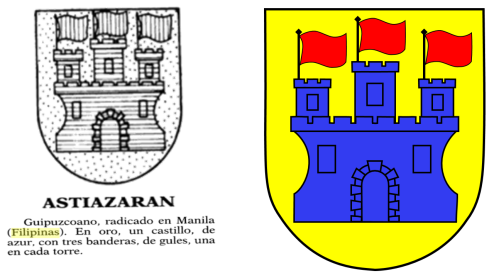
Astiazaran – Originally from Guipuzcoa province, settled in Manila (Philippines). Or, a castle azure of three towers each flying a banner gules. (Source: Heraldario español, europeo y americano, Tomo 2. Colored emblazonment by Rendell Salgado.)
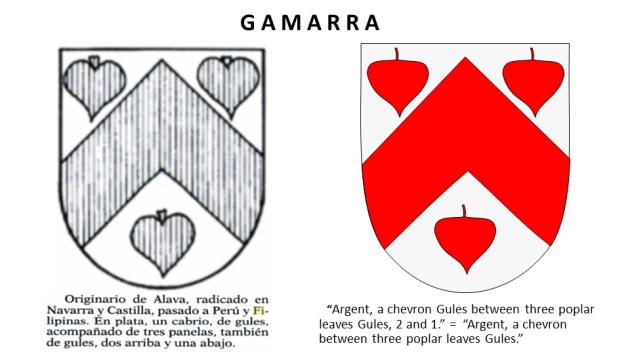
Gamarra – Originally from Alava, settled in Navarra and Castilla, Peru and the Philippines. Argent, a chevron between three poplar leaves Gules. (Source: Heraldario español, europeo y americano, Tomo 4. Blazon translation by Antonio Salmeron Cabañas. Colored emblazonment by Rendell Salgado.)
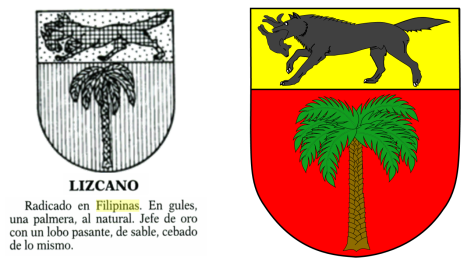
Lizcano – Settled in the Philippines. Gules, a palm tree proper, in chief or a wolf passant sable. (Source: Heraldario español, europeo y americano, Tomo 2. Colored emblazonment by Rendell Salgado.)
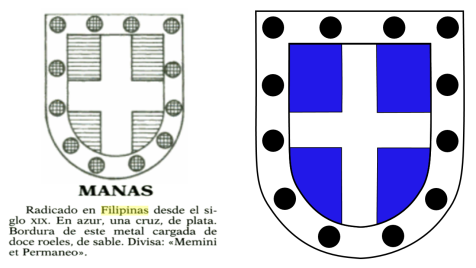
Manas – Settled in the Philippines since the 19th-century. Azure, a cross argent, in a bordure argent charged of twelve bezants sable. Motto: “Remember the Last”. (Source: Heraldario español, europeo y americano, Tomo 6. Colored emblazonment by Rendell Salgado.)
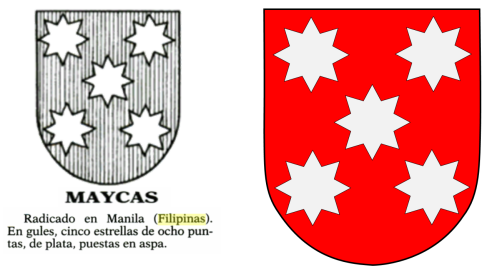
Maycas – Settled in Manila (Philippines). Gules, five mullets of eight points argent. (Source: Heraldario español, europeo y americano, Tomo 5. Colored emblazonment by Rendell Salgado.)
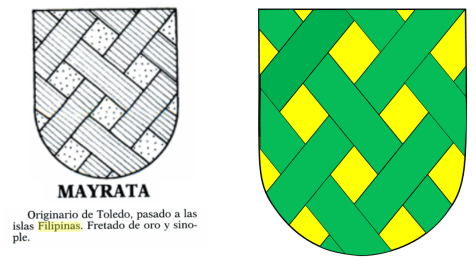
Mayrata – Originally from Toledo, moved to the Philippines. Or, fretty vert. (Source: Heraldario español, europeo y americano, Tomo 3. Colored emblazonment by Rendell Salgado.)
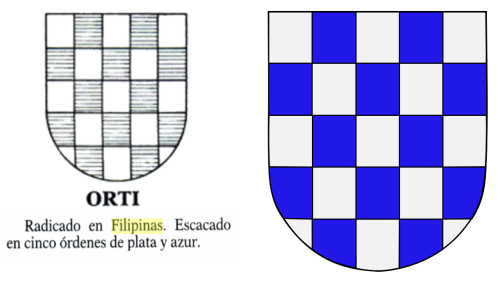
Orti – Settled in the Philippines. Chequy of five, argent and azure. (Source: Heraldario español, europeo y americano, Tomo 3. Colored emblazonment by Rendell Salgado.)
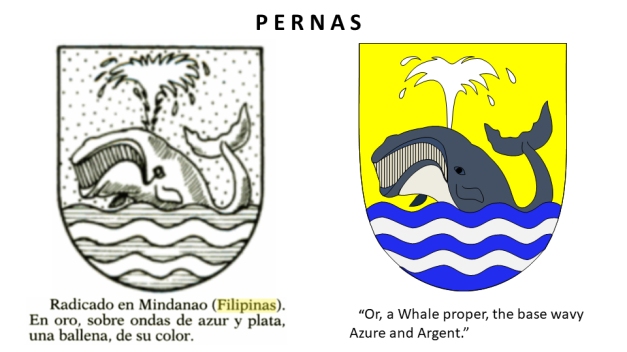
Pernas – Settled in Mindanao (Philippines). Or, a Whale proper, the base wavy Azure and Argent. (Source: Heraldario español, europeo y americano, Tomo 4. Blazon translation by Antonio Salmeron Cabañas. Colored emblazonment by Rendell Salgado.)
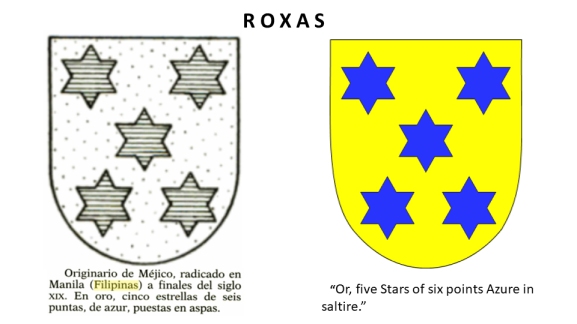
Roxas – Originally from Mexico, settled in the Philippines in the late 19th-century. Or, five Stars of six points Azure in saltire. (Source: Heraldario español, europeo y americano, Tomo 4. Blazon translation by Antonio Salmeron Cabañas. Colored emblazonment by Rendell Salgado.)
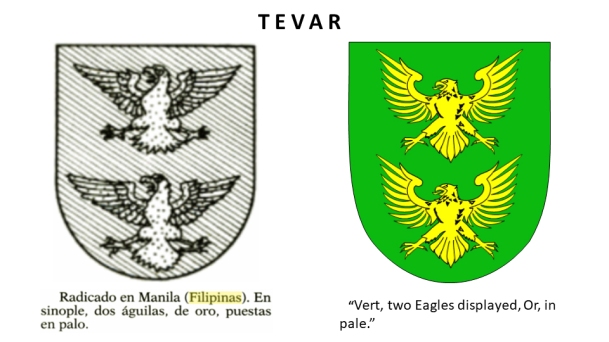
Tevar – Settled in Manila (Philippines). Vert, two Eagles displayed, Or, in pale. (Source: Heraldario español, europeo y americano, Tomo 4. Blazon translation by Antonio Salmeron Cabañas. Colored emblazonment by Rendell Salgado.)
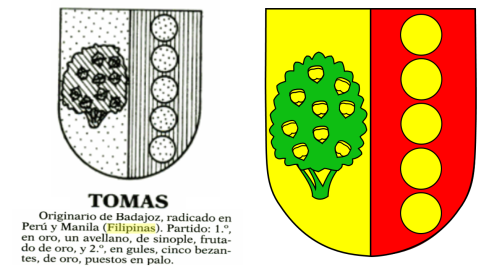
Tomas – Originally from Badajoz, settled in Peru and Manila (Philippines). Per pale or and gules, in dexter a hazel vert fructed or, in sinister per pale five bezants or. (Source: Heraldario español, europeo y americano, Tomo 6. Colored emblazonment by Rendell Salgado.)
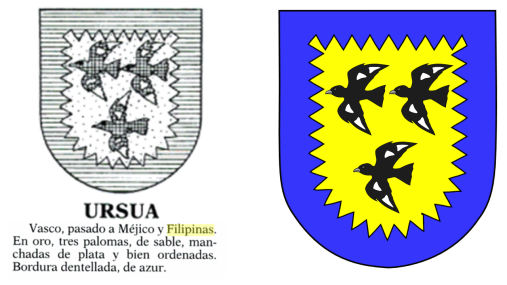
Ursua – Basque, moved to Mexico and the Philippines. Or, three doves sable spotted argent, a bordure dentelly azure. (Source: Heraldario español, europeo y americano, Tomo 3. Colored emblazonment by Rendell Salgado.)
4 thoughts on “Coats of arms of Spanish settlers in the Philippines”